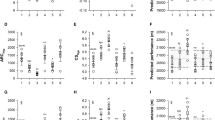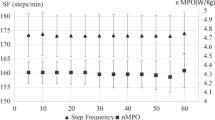Abstract
The aim of this study was to examine the influence of the performance level of athletes on pacing strategy during a simulated 10-km running race, and the relationship between physiological variables and pacing strategy. Twenty-four male runners performed an incremental exercise test on a treadmill, three 6-min bouts of running at 9, 12 and 15 km h−1, and a self-paced, 10-km running performance trial; at least 48 h separated each test. Based on 10-km running performance, subjects were divided into terziles, with the lower terzile designated the low-performing (LP) and the upper terzile designated the high-performing (HP) group. For the HP group, the velocity peaked at 18.8 ± 1.4 km h−1 in the first 400 m and was higher than the average race velocity (P < 0.05). The velocity then decreased gradually until 2,000 m (P < 0.05), remaining constant until 9,600 m, when it increased again (P < 0.05). The LP group ran the first 400 m at a significantly lower velocity than the HP group (15.6 ± 1.6 km h−1; P > 0.05) and this initial velocity was not different from LP average racing velocity (14.5 ± 0.7 km h−1). The velocity then decreased non-significantly until 9,600 m (P > 0.05), followed by an increase at the end (P < 0.05). The peak treadmill running velocity (PV), running economy (RE), lactate threshold (LT) and net blood lactate accumulation at 15 km h−1 were significantly correlated with the start, middle, last and average velocities during the 10-km race. These results demonstrate that high and low performance runners adopt different pacing strategies during a 10-km race. Furthermore, it appears that important determinants of the chosen pacing strategy include PV, LT and RE.


Similar content being viewed by others
References
Abbiss CR, Laursen PB (2008) Describing and understanding pacing strategies during athletic competition. Sports Med 38:239–252
Atkinson G, Brunskill A (2000) Pacing strategies during a cycling time trial with simulated headwinds and tailwinds. Ergonomics 43:1449–1460
Atkinson G, Peacock O, Gibson AS, Tucker R (2007a) Distribution of power output during cycling: impact and mechanisms. Sports Med 37:647–667
Atkinson G, Peacock O, Law M (2007b) Acceptability of power variation during a simulated hilly time trial. Int J Sports Med 28:157–163
Billat V, Lepretre PM, Heugas AM, Laurence MH, Salim D, Koralsztein JP (2003) Training and bioenergetic characteristics in elite male and female Kenyan runners. Med Sci Sports Exerc 35:297–304
Bishop D, Bonetti D, Dawson B (2002) The influence of pacing strategy on VO2 and supramaximal kayak performance. Med Sci Sports Exerc 34:1041–1047
Cohen J, Cohen P (1983) Applied multiple regression/correlation analysis for the behavioral sciences, 2nd edn. Erlbaum, Hillsdale
Costill DL, Thomason H, Roberts E (1973) Fractional utilization of the aerobic capacity during distance running. Med Sci Sports 5:248–252
Coyle EF, Coggan AR, Hopper MK, Walters TJ (1988) Determinants of endurance in well-trained cyclists. J Appl Physiol 64:2622–2630
de Koning JJ, Bobbert MF, Foster C (1999) Determination of optimal pacing strategy in track cycling with an energy flow model. J Sci Med Sport 2:266–277
Duffield R, Bishop D, Dawson B (2006) Comparison of the VO2 response to 800-m, 1500-m and 3000-m track running events. J Sports Med Phys Fit 46:353–360
Fabiato A, Fabiato F (1978) Effects of pH on the myofilaments and the sarcoplasmic reticulum of skinned cells from the cardiac and skeletal muscles. J Physiol 276:233–255
Farrell PA, Wilmore JH, Coyle EF, Billing JE, Costill DL (1979) Plasma lactate accumulation and distance running performance. Med Sci Sports Exerc 11:338–344
Foster C, Snyder AC, Thompson NN, Green MA, Foley M, Schrager M (1993) Effect of pacing strategy on cycle time trial performance. Med Sci Sports Exerc 25:383–388
Foster C, de Koning JJ, Hettinga F et al (2004) Effect of competitive distance on energy expenditure during simulated competition. Int J Sports Med 25:198–204
Foster C, Hendrickson K, Peyer K et al (2009) Pattern of developing the performance template. Br J Sports Med [Epub ahead of print]
Hanon C, Leveque JM, Thomas C, Vivier L (2007) Pacing strategy and VO2 kinetics during a 1500-m race. Int J Sports Med 29:206–211
Heck H, Mader A, Hess G, Mücke S, Müller R, Hollmann W (1985) Justification of the 4-mmol/l lactate threshold. Int J Sports Med 6:117–130
Hettinga FJ, De Koning JJ, Foster C (2009) \( \dot{V}{\text{O}}_{2 } \) response in supramaximal cycling time trial exercise of 750 to 4000 m. Med Sci Sports Exerc 41:230–236
Jones AM, Doust JH (1996) A 1% treadmill grade most accurately reflects the energetic cost of outdoor running. J Sports Sci 14:321–327
Joseph T, Johnson B, Battista RA et al (2008) Perception of fatigue during simulated competition. Med Sci Sports Exerc 40:381–386
Kuipers H, Verstappen FTJ, Keizer HA, Geurten P, Vankranenburg G (1985) Variability of aerobic performance in the laboratory and its physiological correlates. Int J Sports Med 6:197–201
Mattern CO, Kenefick RW, Kertzer R, Quinn TJ (2001) Impact of starting strategy on cycling performance. Int J Sports Med 22:350–355
McCreary CR, Chilibeck PD, Marsh GD, Paterson DH, Cunningham DA, Thompson RT (1996) Kinetics of pulmonary oxygen uptake and muscle phosphates during moderate intensity calf exercise. J Appl Physiol 81:1331–1338
Medbo J, Tabata I (1993) Anaerobic energy release in working muscle during 30 s to 3 min of exhausting bicycling. J Appl Physiol 75:1654–1660
Morgan DW, Baldini FD, Martin PE, Kohrt WM (1989) Ten kilometer performance and predicted velocity at \( \dot{V}{\text{O}}_{2{\text{max }}} \) among well-trained male runners. Med Sci Sports Exerc 21:78–83
Noakes TD, Myburgh KH, Schall R (1990) Peak treadmill running velocity during the \( \dot{V}{\text{O}}_{2{\text{max }}} \) test predicts running performance. J Sports Sci 8:35–45
Perrey S, Grappe F, Girard A et al (2003) Physiological and metabolic responses of triathletes to a simulated 30-min time-trial in cycling at self-selected intensity. Int J Sports Med 24:138–143
Roecker K, Schotte O, Niess AM, Horstmann T, Dickhuth HH (1998) Predicting competition performance in long-distance running by means of a treadmill test. Med Sci Sports Exerc 30:1552–1557
Sjödin B, Jacobs I (1981) Onset of blood lactate accumulation and marathon running performance. Int J Sports Med 2:23–26
St Clair Gibson A, Schabort EJ, Noakes TD (2001) Reduced neuromuscular activity and force generation during prolonged cycling. Am J Physiol Regul Integr Comp Physiol 281:R187–R196
Stockhausen W, Grathwohl D, Bürklin C, Spranz P, Keul J (1997) Stage duration and increase of work load in incremental testing on a cycle ergometer. Eur J Appl Physiol Occup Physiol 76:295–301
Thomas C, Hanon C, Perrey S, Le Chevalier JM, Couturier A, Vandewalle H (2005) Oxygen uptake response to an 800-m running race. Int J Sports Med 26:268–273
Tucker R, Bester A, Lambert EV, Noakes TD, Vaughan CL, St Clair Gibson A (2006) Non-random fluctuations in power output during self-paced exercise. Br J Sports Med 40:912–917
Van Ingen Schenau GJ, de Koning JJ, de Groot G (1994) Optimisation of sprinting performance in running, cycling and speed skating. Sports Med 17:259–275
Acknowledgments
The authors thank Dr. Christine Hanon at the French National Institute of Sport and Physical Education (INSEP) for critical comments. Flávio O Pires is grateful to CAPES for his scholarship.
Conflict of interest statement
None declared.
Author information
Authors and Affiliations
Corresponding author
Additional information
Communicated by Susan Ward.
Rights and permissions
About this article
Cite this article
Lima-Silva, A.E., Bertuzzi, R.C.M., Pires, F.O. et al. Effect of performance level on pacing strategy during a 10-km running race. Eur J Appl Physiol 108, 1045–1053 (2010). https://doi.org/10.1007/s00421-009-1300-6
Accepted:
Published:
Issue Date:
DOI: https://doi.org/10.1007/s00421-009-1300-6




